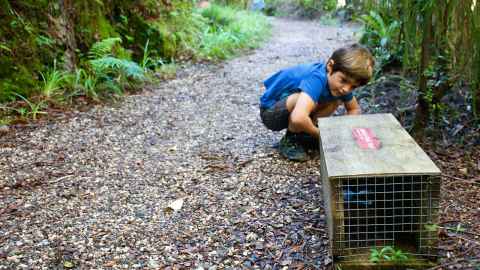Conservation has to go beyond our own backyards
12 April 2019
Opinion: When it comes to conservation, it's time to look up from our backyards and take on the larger vision, writes Associate Professor Margaret Stanley.

In a recent community conservation forum, a community engagement colleague coined the acronym ‘HIMBY’. “It’s the opposite of NIMBY (Not in My Back Yard)” she said. “It HAS to be In My Back Yard – HIMBY”.
And she’s dead right. This particular scenario is increasingly raising its head as community groups voraciously compete for conservation funding and action while failing to see the ‘big picture’ of evidence-based strategy around pest management and restoration.
Of course we desperately need highly activated communities to be engaged in conservation and restoration. We can enhance biodiversity over a larger area with limited resources when community groups and volunteers give their time and energy for free. It’s also important to have place-based conservation - this allows a sense of ownership and community buy-in that allows sustainability of people and groups over time. Ecologists have long since recognised that ecological science alone won’t solve conservation problems, and social science and community partnership is a critical cog in the conservation wheel.
However, we also need to remind our communities about the risks of ‘HIMBY’ and community-based conservation.
One of the major risks of a national emphasis on community-based conservation is that funding could be diverted away from areas that don’t have people - then we could end up in a situation where much of our conservation action is not taking place on land that is representative of different ecosystem types/biodiversity. In fact, we know that community conservation is biased towards coastal forest ecosystems, where people are concentrated.
At a local level, where funding and resources are prioritised and allocated within regions or cities, ‘HIMBY’ is alive and well. Community groups within cities/regions are understandably vying for resources. However, prioritisation of pest management must incorporate more than community activation.
Firstly, it must be cost-effective and have preventative outcomes, rather than the ambulance at the bottom of the cliff. We should prioritise prevention. The Treasure Islands programme which funds pathway biosecurity to prevent pest invasion on Hauraki Gulf Islands both protects assets with previous large investment in removing pests (for example, Rangitoto and Motutapu Islands), and prevents new invasions, thereby saving money in the long term. We know how cost-effective it is in medicine to vaccinate rather than belatedly treat the disease.
Given the impacts of Aotearoa-New Zealand’s invasion debt, we have to continue to ‘treat the disease’ and reduce pests and restore habitat. But the ‘where’ should be decided strategically. Yes, the degree to which a community is activated is a key factor in prioritisation along with other cultural and societal factors, but ecological factors (beyond our backyards), such as level of pest infestation, the value of the conservation assets within sites, and habitat connectivity, should be key factors in deciding where conservation actions should take place to achieve the best outcomes for biodiversity across the city or region.
Although we’re primed as humans to be highly attached to ‘our backyard’ and want the best outcomes for it, we need to see the wood for the trees. This is why larger-scale conservation visions, such as the North-West Wildlink and Cape to City are becoming increasingly important. If we can all buy into the larger landscape scale conservation vision, then we will be willing to see that the priorities for action and dollars spent might not be in our backyard, but over the fence, in someone else’s backyard. We’ll also understand that by taking action in the neighbour’s backyard, we will benefit from the biodiversity spilling over into our backyard.
Time to look up from our backyards and take on the larger vision.
Associate Professor Margaret Stanley is from the School of Biological Sciences at the University of Auckland. This article reflects the opinion of the author and not necessarily the views of the University of Auckland.
Used with permission from Newsroom Conservation has to be in our own backyards published on 12 April 2019